Nowadays, the best laptops under £500/$500 are surprisingly well equipped, with many offering solid enough performance to handle a variety of creative tasks and respectable design specs.
Based on the years of our collective expertise and testing, we’ve reviewed and compared all of the laptops in this guide, weighing them against both more professionally-equipped devices as well as machines within the same price range. For the full breakdown of our process, check out how we test laptops as well as the testing section below.
Each laptop below has been hand-picked for a variety of use cases, and in fact, many appear as entries in a variety of our guides, including the best laptops for photo editing, the best laptops for graphic design and the best laptops for students. Without further delay, here are the best affordable laptops we’ve tested.
Quick list
If you’re looking for a quick summary of the best options available, this quick list gives you a short-form breakdown of your options with links to jump down to read more below.
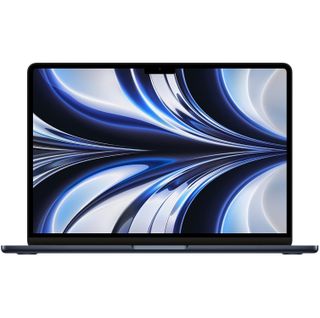 Best Apple
Best Apple
The MacBook Air M2 is a great all-rounder, offering solid specs across the board in an ultra-lightweight frame. With newer generations now on the market, it’s a far more affordable option if you want to revel in Apple’s ecosystem.
Read more below
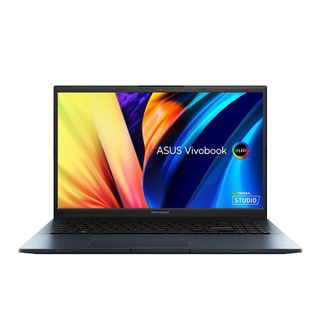 Best for video editing
Best for video editing
Offering a solid balance of performance, a beautiful display and great value for money, the Vivobook Pro 15 OLED is particularly good for video editing, but it’s also another excellent all-rounder to add to the list.
Read more below
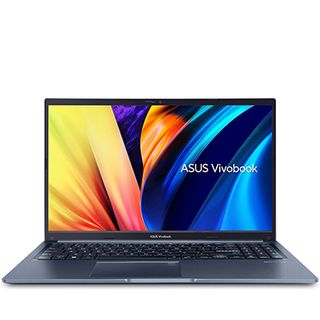 Best for photo editing
Best for photo editing
While the ASUS Vivobook Pro 16 is another fantastic all-around laptop for creatives, we think it’s particularly good for photo editing, thanks to the expansive display size, colour accuracy, and vibrancy. It’s plenty powerful too, though the battery life leaves a little to be desired.
Read more below
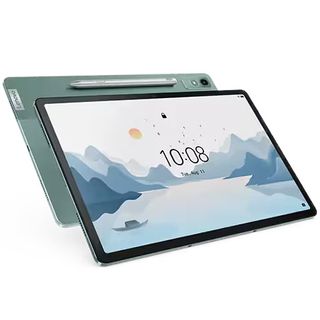 Best 2-in-1
Best 2-in-1
The Acer Chromebook Spin 714 pairs an approachable price point with some premium features in a neat ChromeOS 2-in-1 format. Its display is great, it’s built to last and it’s the laptop to beat if you want both versatility and value.
Read more below
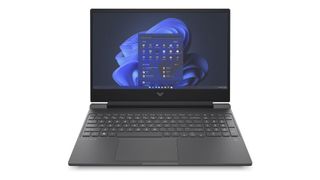 Best for graphic design
Best for graphic design
It looks like a budget gaming laptop, it’s specced like a budget gaming laptop – and that’s because it is one! The HP Victus 15 is slightly dated in terms of hardware, but it offers enough power for graphic design off the back of its gaming specs and for good value.
Read more below
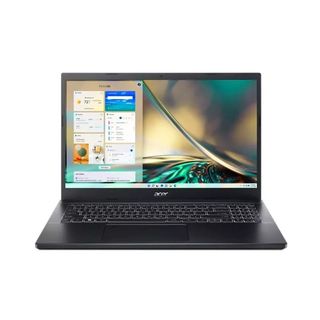 Best for Cricut
Best for Cricut
While it’s screen is a little dull, the Acer Aspire 7 A715-76G is a respectably powerful laptop with decent It has a decent battery life, but most importantly offers great value for money when you consider hardware it contains under the hood.
Read more below
Best value Apple laptop
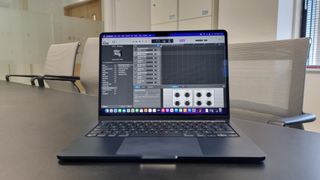
01. Apple MacBook Air (M2, 2022)
This MacBook for video editing offers excellent value.
CPU: Apple M2 (8-core CPU) | Graphics: 8-core GPU or 10-core GPU | RAM: 8GB, 16GB, 24GB | Screen: 13.6-inch, 2,560 x 1,664 Liquid Retina display | Storage: 256GB, 512GB, 1TB, 2TB | Ports: 2x Thunderbolt 3 (USB-C), 3.5mm headphone jack, MagSafe 3 charging port
While it’s not using Apple‘s most recent powerful M4 chip, the M2 used in the 2022 MacBook Air is still a respectable processor that is well suited for lightweight to moderate creative tasks if you’re not quite ready to splash out on a higher spec device.
It’s not just processing power that benefits from Apple silicon; the battery life is excellent, lasting for over 16 hours during our testing when playing a 1080p video on loop. There’s no fan inside the 2022 MacBook Air on account of the highly efficient chipset, but we did find on test that during the heaviest DaVinci editing tasks, it could lag slightly.
The price has dropped a fair bit since its original release on account of newer, higher-spec MacBook Air devices hitting the market, making it an excellent value option for creatives. Plus, due to its dating hardware, it’s an Apple device more likely to see significant discounts and deals during sales events like Black Friday. To squeeze the most value, we’ve picked the 13-inch MacBook Air as our top value choice, but if you want more real estate also check out the 15-inch MacBook Air (M2).
Read our Apple MacBook Air (M2, 2022) review for more info.
Best value laptop for video editing
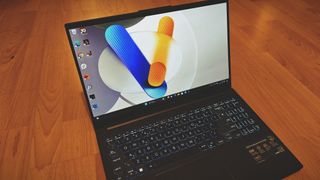
02. ASUS Vivobook Pro 15 OLED (2024)
The best value laptop for video editing
CPU: 14th Gen Intel Core Ultra 7 155H | Graphics: NVIDIA GeForce RTX 4060 Laptop GPU | RAM: 16GB | Screen: 15-inch 2880×1620 OLED, 120Hz, 617 nits peak brightness | Storage: 1TB | Ports: Thunderbolt 4, USB-C 3.2 Gen 2, 2x USB-A 3.2 Gen 1, HDMI 2.1, SD 4.0 card reader, RJ45 Ethernet, 3.5mm audio jack
Scoring well across the board for its power, display quality and affordability, the ASUS Vivobook Pro 15 OLED (2024) is an excellent choice for video editors and other visual creatives. Combining an Intel Core Ultra processor with an integrated NPU and the NVIDIA RTX 4060 GPU, the Vivobook Pro 15 OLED offers ample power for video editing tasks.
During our benchmark testing for digital content creation, the Vivobook Pro 15 held up its own with scores that can even rival more expensive options. Plus, video editors will delight in its gorgeous 15-inch 3K OLED display which boasts 100% DCI-P3 coverage and Pantone certification, as well as its comprehensive port selection, including a fast SD card reader for speedy media transfers.
If you like to edit on the road, the Vivobook Pro 15 OLED is relatively lightweight at 1.8kg, and although it lacks a touchscreen, the ASUS DialPad integrated into the touchpad offers intuitive control over editing functions. The built-in audio leaves something to be desired, a common trait among even the most premium clamshells, but overall the Vivobook Pro 15 OLED (2024) offers exceptional value for money, packing plenty of power and versatility for video editors on the rise.
For more details, read our Vivobook Pro 15 OLED (2024) review.
Best value laptop for photo editing
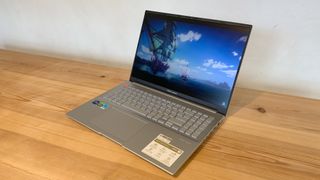
03. Asus Vivobook Pro 16
Solid photo-editing specs for less money
CPU: Intel Core i7-12700H to i9-13900H | Graphics: Up to NVIDIA GeForce RTX 4060 Laptop GPU | RAM: 8GB or 16GB | Screen: 16-inch 2560 x 1600 or 3200 x 2000, 16:10 aspect ratio | Storage: Up to 1TB SSD | Ports: 1x USB C power delivery, 2x USB 3 A, 1x Thunderbolt 4 with display support and power delivery, 1x HDMI 2.1, 3.5mm audio, 1x Ethernet, SD card reader, Micro SD card reader
A respectable value laptop overall, the Asus Vivobook Pro 16 is a capable, affordable laptop for creatives who don’t need a huge amount of power, but do need enough dedicated graphics for photo editing.
While its Pantone-validated colour coverage is slightly narrower than other models on our value list, it’s still accurate and versatile, with its OLED display providing excellent contrast and 600 nits of peak brightness. Its casing is robust and well-made, but keeps the weight low; at 1.9kg, it’s still a fairly lightweight 16-inch laptop, and wonderfully portable.
Of course, its battery life can’t quite live up to the higher spec devices on the market; we only squeezed three hours of battery life out of the Asus Vivobook Pro 16 while photo editing during our testing, though naturally, it’ll last a lot longer in general use scenarios.
Read more in our full Asus Vivobook Pro 16 review
Best value 2-in-1
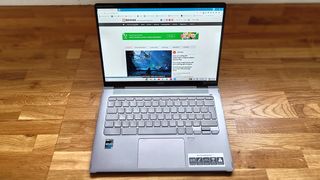
04. Acer Chromebook Spin 714
Best value 2-in-1
CPU: 12th-Gen Intel Core i5-1235U | Graphics: Intel Iris Xe Graphics eligible | RAM: 8/16GB | Screen: 14-inch 16:10 WUXGA 1920 x 1200p IPS touch display | Storage: 256/512GB SSD
2-in-1 laptops offer excellent versatility, especially for creatives who might need to sketch or use tactile controls while working on a project. As a budget option, the Acer Chromebook Spin 714 ticks plenty of boxes; it’s well-built, has a decent 14-inch touch display and packs some decent enough hardware in its various configurations.
The model we tested used a 12th-Gen Intel Core i5 processor, coupled with 8GB of RAM, and handled standard computing tasks such as video streaming and calls with ease. Even with 30 tabs open and multitasking between video calls, streaming and writing, the Spin 714 ran smoothly.
Sure, it’s no rendering power-house, and the fidelity of colours and artwork won’t blow you away, but as a general-use, easily-accessible supporting device, the Spin 714 is a fantastic option. It smoothly moves between its two configurations on two 360-degree hinges, the slim 14-inch screen features narrow bezels and is smooth to the touch, and the cheapest configuration comes in at just $699 / £599 (Intel Core i3, 8GB RAM, 256GB SSD model), while the pricier model with 12th-Gen Intel Core i5, 8GB RAM and 512GB build is $999 / £1,099.
Read more: Acer Chromebook Spin 714 review
Best value laptop for graphic design
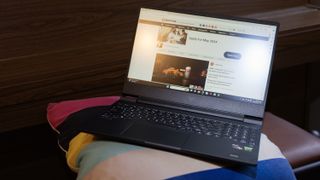
05. HP Victus 15
The best value laptop for graphic design
CPU: AMD Ryzen 7 5800H | Graphics: Nvidia GeForce 3050Ti | RAM: 8GB | Screen: 15in, 1080p IPS, 144Hz | Storage: 500GB SSD | Ports: Wi-Fi 6, Bluetooth 5.3, 2x USB 3 Type-A, 1x USB 3 Type-C, 1x HDMI 2.1, Ethernet, headphones, SD card reader
For its list price, we think the HP Victus 15 is a great value grapic design laptop, offering a great blend of specs that will meet the demands for a majority of workflows with an approachable price point.
It’s on the plain side, design-wide, with a decent 15.6-inch display which disappoints slightly in terms of colour accuracy and vibrancy. Our benchmark tests only identified 64% of sRGB, 48% of Adobe RGB, and 47% of P3 – but you could use a dedicated monitor for graphic artists if this is a huge issue. There’s a good array of ports, and it’s comfortable in use despite a slightly jammy trackpad.
When we tested the HP Victus 15’s performance, it scored respectably when using Photoshop until it came to generative AI tools on larger files. Specifically, the RTX 3050Ti GPU we tested delivers power enough to handle graphic design at an approachable price point, but lower power configurations likely won’t fit the bill.
There’s room for improvement; battery life is middling, its offers a sub-par 250 nits of brightness, but the screen refresh is pretty decent, and its low low price compared to much of the competition makes it a solid entry-level machine for graphic designers.
Read more in our HP Victus 15 review
The best value laptop for Cricut
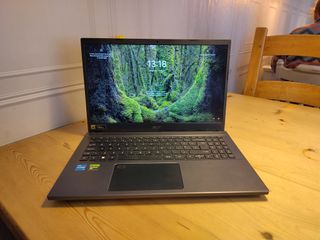
06. Acer Aspire 7
A solid budget laptop for Cricut makers
Operating system: Windows 11 | CPU: Intel Core i5-12450H | RAM: 16GB | Ports: 1 x HDMI, 3 x USB-A, 1 x USB-C thunderbolt, Ethernet, Audio jack | Display: 15.6-in Full HD (1920 x 1080) 16:9 IPS 144 Hz
Cricut‘s software isn’t particularly power-hungry, nor are many bespoke design programs, but you’ll still want a good all-rounder laptop with some room to grow.
Enter the Acer Aspire 7, a cheap laptop with decent enough power. Its build quality matches its low price tag; plastic, but solid enough, however more impressive and important is how configurable the Aspire 7 is, allowing you to open the hood and upgrade the RAM and storage if needed. There’s a good range of ports, including HDMI as well as USB-A and USB-C, too.
Performance-wise, during our testing the Acer Aspire 7 demonstrated plenty of power to handle Cricut tasks, scoring well for rendering and visualisation and photo editing in our benchmark tests. It will struggle with more complex tasks like video editing, but broadly speaking its 16GB RAM will keep things ticking along smoothly. Battery life is similarly middling, offering roughly six hours of moderate workload.
The biggest disappointment is itd 15.6-inch display, with a low 202-nit brightness and poor colour accuracy displaying only 58.1% sRGB colours. However, at this price, that’s to be expected, really, and these aren’t vital specs for most Cricut designers, especially if you’re a hobbyist or running a small operation.
Read more: Acer Aspire 7 review
Best value laptop for 3D modelling

07. ASUS TUF Gaming F15
The best budget laptop for 3D modelling
CPU: Intel® Core™ i9-13900H | Graphics: NVIDIA® GeForce RTX™ 4070 Laptop GPU | RAM: 16GB-32GB DDR5-4800MHz | Screen: 15.6-inch display with FHD (1920×1080 pixels) | Storage: 512GB-2TB SSD
The 2023 ASUS TUF Gaming F15 isn’t just good for demanding 3D applications; it’s built for it. Armed with the latest 13th Gen Intel CPUs and NVIDIA RTX 40 Series GPUs and packaged in a durable shell, the TUF Gaming F15 manages to keep the price low while still delivering everything you’ll need for 3D modelling.
It’s not just powerful; the TUF Gaming F15 also houses a decent 15.6-inch FHD display with a 144Hz refresh rate, which also makes it a great choice for casual gaming. It’s worth noting that this family of laptops doesn’t offer top-of-the-range screen quality, so if your creative projects often feature colour-critical work, you might be better off with a different value laptop like the Asus Vivobook Pro 15 OLED listed above.
The design is also a little clunky, which is par for the course with gaming laptops, but it’s far from problematic. The trade-off is that you benefit from hardware like DDR5 RAM and fast SSD storage to smooth multitasking and ensure quick file access.
See our full ASUS TUF Gaming F15 review of the 2022 version.
Best value laptop for programming
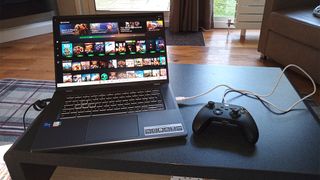
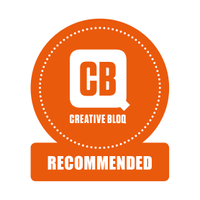
08. Acer Chromebook 516 GE
The best budget laptop for programming
CPU: Intel Core i5-i7 | Graphics: Intel Iris Xe | RAM: 8-16GB | Screen: 16″ WQXGA (2560 x 1600) IPS, 120Hz | Storage: 256GB NVMe SSD
Often the more affordable option, Chromebooks present a great value proposition for programming. While you’re limited to cloud-based tools and it’s not the most powerful machine, 516 GE has some decent specs as far as the hardware goes, with 12th Gen Intel Core i5 processor (with an i7 option available), Intel Iris Xe graphics, 8GB of RAM and 256GB NVMe SSD.
During our testing, our reviewer felt performance rivals many conventional Windows laptops, offering zippy file access, smooth multitasking and a large 16-inch WQXGA display with a 120Hz refresh rate that provides ample screen real estate and smooth visuals. When it comes to programming, this is surprisingly important, maintaining your eye health over long periods quizzing code, but the comfort offered by the 516 GE extends further with the Chromebook’s premium build quality, backlit keyboard, and long battery life.
Still, you’ll need to consider the reliance on a strong internet connection for some tasks and the limitations of ChromeOS, but it’s a decent, portable and relatively versatile device that’ll easily handle your programming needs.
For more details, read our Acer Chromebook 516 GE review.
Best value laptop for writers
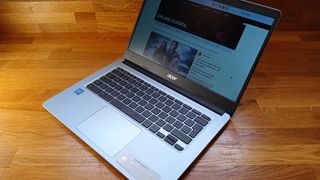

09. Acer Chromebook 314
You just want to write? This is the best option.
CPU: Intel Celeron N4000 1.1Ghz (dual-core) | Graphics: Intel UHD Graphics 600 | RAM: 4GB | Screen: 14-inch 1080p | Storage: 32GB
Another Chromebook takes top spot for offering solid value when it comes to creative work; the Acer Chromebook 314 stands the test of time, maintaining its spot as our number one pick for writers for the second year running.
The Chromebook 314 has maintained its position thanks to its fantastically low price point of around $200/£300, but it also has some decent specs. Its battery life is great, there are a number of excellent word processors available for Chrome OS, and it’s wonderfully portable for writers who prefer to be out and about while they work on their magnum opus.
There are a few drawbacks, naturally; the 314 has limited internal storage, meaning you’ll be reliant on cloud storage, and although Chrome OS is easier than ever to use offline, you’ll still need to rely on internet connectivity more than you would a traditional Windows or Apple laptop.
Still, its keyboard is comfortable to use over long periods of typing, the anti-glare, matte finish screen reduces eye strain and it’s a decent size; just be sure to opt for the 1080p screen if screen resolution is important to you.
See our hands-on Acer Chromebook 314 review for more details.
Best value laptop for drawing
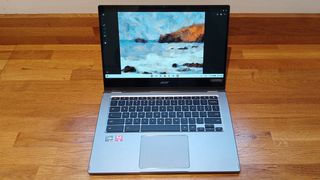
10. Acer Chromebook Spin 514
The best budget laptop for drawing
CPU: AMD Ryzen 5 3500U processor quad-core 3.7 GHz | Graphics: AMD Radeon Graphics shared memory | RAM: 8 GB | Screen: 35.6 cm (14″) Full HD (1920 x 1080) 16:9 Touchscree | Storage: 128 GB Flash Memory
Once again, the budget king Chromebook format swoops in to steal another value proposition crown, but this time it’s the Acer Chromebook Spin 514 coming out on top for drawing.
With zippy performance even while using midweight software in the cloud, it’s only more demanding workflows that will really struggle with the Spin 514. Its 14-inch Full HD touchscreen is fantastic for drawing, offering a 16:10 ratio that grants extra space for drawing. It’s easy to connect a stylus, compared to other Chromebooks, thanks to its USB-C port, and wonderfully versatile in both its tablet and laptop mode.
We were really impressed by its performance at this price point, but also its excellent build quality, making it a great value drawing laptop you can easily stash in your satchel and take out on the town.
For more information, see our Acer Chromebook Spin 514 review.
Best value laptop for students
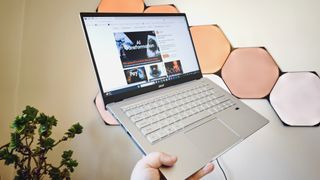
It’s not new, nor glamorous, but the Acer Swift 3 is a humble yet robust machine that will easily meet the needs of students throughout the duration of their studies.
Wrapped in aluminum, the laptop houses a 16:9 display with slightly thicker bezels than in contemporary premium models, but it’s still slim and lightweight at just 1.19kg. The keyboard is easy and comfortable to type on, and there’s a fingerprint reader and Kensington lock slot included in the device includes thoughtful features like a fingerprint reader and Kensington lock slot to keep it safe and secure even on a busy campus. Port selection includes USB-C with DisplayPort support, two USB-A ports, and HDMI.
The display is far from exceptional, but a 14-inch Full HD IPS screen is nothing to sniff at, so long as you’re not planning on gaming, where the 60Hz refresh rate might disappoint. Based on our testing, its color accuracy is respectable enough for entry-level or junior design work (100% sRGB, 76% AdobeRGB, 76% P3), however the Swift 3 didn’t score particularly well in our benchmark tests, and it’s certainly not suitable for more complex and power-hungry creative software.
Read more in our Acer Swift 3 review.
How to choose the best value laptops
Choosing the best value laptop will depend on your needs and budget, as not all affordable machines are made equal. Some devices on this list check in at over $1000/£1000, but use the minimum specs for their intended use case, making them the best possible option based on our testing and expertise on the minimum requirements for creative work.
Of course, you might need a laptop that’s capable of cross-discipline work. The easiest way to choose, in that scenario, will be by assessing which media you’ll be the using most, or which has the more specific minimum requirements, and shopping with that use case in mind.
Still, there are some solid all-rounders listed above that offer great specs and scores on a variety of metrics and will likely work well for multiple disciplines. In that case, the biggest differentiator will naturally be price.
How we tested the best student laptops
All the laptops in this guide have been tested by Creative Bloq’s hardware experts, who push each device to their limits with benchmark tests, real-world experiments and daily use over extended periods.
Our reviewers have considered how different types of creatives use their devices and what features or specs register as the most important, accordingly, and emulate these scenarios in our testing. We run different benchmark tests on each device depending on its intended use by its maker, but the laptops we’ve included in this guide will have been run through all or most of the following tests:
• Cinebench R23/2024 – this assesses the performance of a computer’s CPU and GPU using real-world 3D rendering tasks
• Geekbench 5/6 – this tests the CPU’s processing power, both by using a single core for a single task at a time as well as all the CPU’s core to see its ability to multitask
• Handbrake – we use this free and open-source transcoder for digital video files to render a short 4K animated film, using the same file for all our tests
• 3DMark – this assesses a computer’s ability to run graphic rendering tasks, including for gaming
• PCMark 10 – this test assesses a computer’s ability to run all everyday tasks from web browsing to digital content creation, testing app launch speeds, 3D rendering and even battery life
For more details, see our article on how we test.
FAQs
What’s the best brand of value laptops?
Most, if not all, laptop manufacturers will produce some kind of entry-level, value-first laptop, but these can vary wildly in price depending on the brand. There are some that are particularly commended for their affordable laptops that aren’t just cheap; they offer high value. Acer is a clear leader on this front based on the sheer volume of devices made by the brand featured in this list, but Asus also offers respectable contributions in the mid-range market.
How do I save money on a laptop?
You’ll likely have noticed many laptops featured in this guide are older generation devices from the past two to three years, and that’s because while they still stand the test of time in terms of hardware, they’ve since been replaced and downvalued by newcomer devices.
Waiting for new generation machines is just one way to save some money; if you want to save even more, every year there are a plethora of sales events and deals, as well as special student discounts available all year round, like the Apple Student discount, Samsung Student discount or the Dell student offers.
What is the average price of a decent laptop?
Laptop value and pricing varies wildly depending on the brand, the software and also the intended use for the device, but broadly speaking a solid all-rounder will cost somewhere in the realms of $500 / £500 to $1000 / £1000. This will net you a capable clamshell when it comes to productivity, some degree of processing power for lower-end creative tasks and a decent enough screen. However, if your skills and demands are likely to ramp up quickly, you’re better off spending a little more to get a future-proofed machine.
Do Chromebooks make good value laptops?
Absolutely, they do. As shown by our list, Chromebooks often occupy the top value spot for a wide variety of use cases, though any render-based creative tasks will be a challenge for the average Chromebook. However, for entry-level creatives or students, a Chromebook makes an excellent stepping stone or even a second screen.
